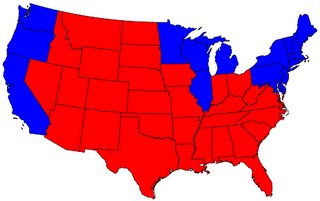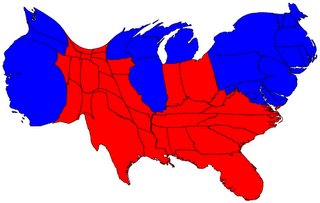Do red state maps prove anything?
Does the 2004 election prove that the country is primarily red? An interesting twist on the usual red-blue maps is available at Maps and Cartograms of the 2004 Presidential Election. The authors note that the followoing purely state map is misleading:

If you make a map that takes population into account, you get the following:

And if you take counties and percentages into account, and shade colors from red to blue by the percentage votes, you come up with a truly complex conclusion of where we stand on red v. blue:

What are the views of all of those purple counties?
Food for thought.

If you make a map that takes population into account, you get the following:

And if you take counties and percentages into account, and shade colors from red to blue by the percentage votes, you come up with a truly complex conclusion of where we stand on red v. blue:

What are the views of all of those purple counties?
Food for thought.

1 Comments:
O.k., I thought about it. Then I thought about it some more. But in the end, I'm of the persuasion that they've taken a pretty simple concept and complicated it unnecessarily.
The population weighting may seem to be the “real” red vs. blue accounting, and the state-by-state electoral breakout may seem only superficial, but the states are the primary constituent units of US government, making the popular vote in each state (=electoral vote) the one that matters.
This is best seen in the composition of the Senate. Those who comfort themselves with the argument that, on a population-weighted basis, the areal extent of blue states is roughly equal to that of red states, are in fact minimizing the very real risk that the Senate’s movement to the right has only begun and may well continue until the situation approaches the reverse of 1958 (when Johnson, as majority leader, disposed himself of 65 votes – and he was very good at keeping them all in line).
Toting up the blue states, one finds there were only 19 of them in the 2004 election. That’s 38 Senate seats. The other 62 are in the red states. Senate races are decided, as we all know, by statewide popular votes, state by state. In other words, it happens in the same way that electoral votes are determined. If the composition of the Senate were to be fixed every four years by the Presidential vote, then there would be 62 Republican senators.
But Senatorial elections are every six years and, more importantly, incumbents are very hard to dislodge, often leaving only by way of retirement. Some of the seats that made up Johnson’s 1950s majority have still to be dislodged by the Republicans.
What can be done about this? I can’t think of anything at all. Johnson’s majority (including Johnson himself) represented, as we all know, an unholy alliance between the northern branch of the Democratic party, dominated by industrial unions and the vestiges of the “machine” politics of earlier decades, and the southern branch, the so-called Solid South, dominated mainly by a (heavily racist) Southern abhorrence of the Republican Party that had been constant since its origins in the Civil War.
Here’s the map of the 1860 Presidential vote, which, in the southern and border states, might as well have been called the Vote Against Lincoln: http://teachpol.tcnj.edu/Amer_pol_hist/fi/000000bd.htm. That situation remained essentially unchanged, not only in Johnson’s time, but later, at least through Carter’s Presidency. In fact, when Reagan was re-elected, most of the South was still in the hands of Democrats even in the House. That’s how slowly the worm turns.
But today, the Republicans, the Party of Mischief (starting just about from the moment when Booth pulled the trigger on this religious holiday 141 years ago), have completely erased what was seemingly a deathless antipathy toward them throughout the counties of the Old South (except, of course, the relatively few counties that are majority black, where the migration of voting allegiances went in the opposite direction, sometime early in the twentieth century). Those southern House seats are mostly in Republican hands now, and that leaves the remaining southern Senate seats.
There are five of them left. Of those, two are the West Virginia seats, with two more in Arkansas and the last one Mary Landrieu in Louisiana. Does this erode my argument? It seems so, at least at first glance.
West Virginia is historically associated with the United Mine Workers rather than the Old South, so one could argue those seats should be counted as blue. BUT: the state voted red in the 2004 election, and the fact is, though the mines are booming, there are hardly any mine workers left, employment in the industry being but a fraction even of reduced totals from twenty years ago. Fact is, fundamentalism is what’s really booming in West Virginia. Byrd is over eighty and will soon have to be carted off. Will that be the end of Democrats’ hold on that seat? It’s hard to imagine the Republicans defeating a Rockefeller, so maybe I’ll take my “ultimate Republican Senate majority” down one notch, to 61 – at least for the next few elections.
Still, even if you count West Virginia, that’s only five seats in the South left to change hands, implying the Republicans top off at 60 seats (59, assuming Rockefeller can hold, which is nice, considering the cloture requirement).
But the mentality of mischief that drew the South to the Republicans isn’t really limited to the geographical confines of the Old South, is it? It spreads across the “Heartland” doesn’t it? There are so many of those “safe” Republican states spread across the bright red middle of the country –– aren’t there? And all of them good candidates for a Republican lock on control of their Senate seats. Counting up the Senate seats in the Plains and the Rockies, plus Indiana that remain in Democratic hands, there are TEN of them… Uh-oh!
Some seem safe – Bayh in Indiana, Harkin in Iowa, Reid in Nevada (but Daschle, our previous minority leader is gone), Salazar in Colorado – but it wouldn’t take many to start pushing the Republicans up toward sixty seats, or, if you assume a Solid South (but this time for the Republicans), toward that 65-seat majority that Johnson commanded for the Democrats of the late 1950s.
And all of this reasoning is premised upon Democratic control of blue-state Senate seats, an assumption that is at best shaky when you consider the culprits up here in our neck of the woods, Snowe (a shoo-in for re-election this year), Collins, Sununu and Judd (or is it Gregg? – guy’s got his name reversed). If those are safe seats for the Republicans, then the worst-case scenario is a Republican majority of nearly 70 seats!
Oh well.
The time is right for marching in the streets.
Post a Comment
<< Home